Articles
- Page Path
- HOME > Korean J Community Nutr > Volume 17(5); 2012 > Article
-
Original Article
- A Study on Nutritional Status and Dietary Quality of University Students by Body Image
- Jee-Young Yeon, Seung-Hee Hong, Yun-Jung Bae
-
Korean Journal of Community Nutrition 2012;17(5):543-554.
DOI: https://doi.org/10.5720/kjcn.2012.17.5.543
Published online: October 31, 2012
Nutrition Policy Division, Nutrition Policy Office, Korea Food and Drug Administration, Chungcheongbuk-do, Korea.
1Department of Food and Nutritional Sciences, Hanbuk University, Gyeonggi-do, Korea.
- Corresponding author: Yun-Jung Bae, Department of Food and Nutritional Sceiences Hanbuk University, 233-1 Sangpae-dong, Dongducheon-si, Gyeonggi-do 483-777, Korea. Tel: (031) 860-1445, Fax: (031) 860-1449, byj@hanbuk.ac.kr
Copyright © 2012 The Korean Society of Community Nutrition
- 929 Views
- 5 Download
- 16 Crossref
Abstract
- This study was performed to investigate the satisfaction of body image, dietary habits, nutrition intake and dietary quality according to body image of university students (n = 290). The subjects (male = 178, female = 112) were classified to lean, normal and overweight/fat groups according to body image. The weight, body fat and body mass index (BMI) was significantly higher in the students who recognized their body image as 'overweight/fat'. The satisfaction of body image, interest of weight control and experience of weight control were significantly higher in students who recognized their body image as 'normal' in both the male and female subjects. The intakes of nutrients, dietary habits and life styles were not different according to body image. In the male subjects, the niacin intake density, the nutrient adequacy ratio (NAR) of vitamin B1 and the dietary diversity score (DDS) in the students who recognized their body image as 'overweight/fat' were significantly lower than in students who recognized their body image as 'normal' and 'lean'. In female subjects, no significant differences in nutrient intakes, NAR, MAR and DDS were observed according to body image. Future studies with a larger sample size are needed for further assessment of the relationship between nutritional status/diet quality and body image in university students.
- 1. Bae YJ, Kim EY, Yeon JY, Cho HK, Lee JS, Kim MH, Kim MH. Evaluation of dietary behavior, nutrient and food intake status, and dietary quality based on Diet Quality Index-International (DQI-I) in female university students. J East Asian Soc Diet Life. 2010; 20(4): 491-501.
- 2. Chin JH, Chang KJ. College students' attitude toward body weight control, health-related lifestyle and dietary behavior by self-perception on body image and obesity index. J Korean Soc Food Sci Nutr. 2005; 34(10): 1559-1565.Article
- 3. Chung HK, Lee HY. The concepts of weight control and dietary behaviors in high school seniors. Korean J Nutr. 2010; 43(6): 607-619.Article
- 4. Hong MS, Pak HO, Sohn CY. A study on food behaviors and nutrient intakes according to body mass index and body image recognition in female university students from Incheon. Korean J Food Nutr. 2011; 24(3): 386-395.Article
- 5. Jin YH, You KH. A study on the eating habit and eating out behavior of the university students in the Gyeonggi area. Korean J Community Nutr. 2010; 15(5): 687-693.
- 6. Kant AK, Block G, Schatzkin A, Ziegler RG, Nestle M. Dietary diversity in the US population, NHANES II, 1976-1980. J Am Diet Assoc. 1991; 91(12): 1526-1531.ArticlePubMed
- 7. Kant AK. Indexes of overall diet quality: a review. J Am Diet Assoc. 1996; 96(8): 785-791.PubMed
- 8. Kim KH. Comparisons of dietary, living habits and blood parameters in underweight and overweight university students. Korean J Food Cult. 2006; 21(4): 366-374.
- 9. Kim MH, Jeong ES, Kim EJ, Chol HK, Bae YJ, Choi MK. Night eating status of university students in partial area of Chungnam. J East Asian Soc Diet Life. 2011; 21(4): 563-576.
- 10. Kim SY, Lee HM, Song KH. Body image recognition and dietary behaviors of college students according to the body mass index. Korean J Community Nutr. 2007; 12(1): 3-12.
- 11. Krebs-Smith SM, Smiciklas-Wright H, Guthrie HA, Krebs-Smith J. The effects of variety in food choices on dietary quality. J Am Diet Assoc. 1987; 87(7): 897-903.ArticlePubMed
- 12. Lee JH, Kim MS, O JH. A comparative study on perceptions of body image, body satisfaction, and dietary habits of beauty art major and non-major female college students. J East Asian Soc Diet Life. 2007; 17(4): 463-473.
- 13. Ministry of Health and Welfare [MOHW]. Korea Center for Disease Control and Prevention [KCDCP]. Korea Health Statistics 2009: Korea National Health and Nutrition Examination Survey(KNHANES IV-3). 2010; Seoul.
- 14. Mirmiran P, Azadbakht L, Esmaillzadeh A, Azizi F. Dietary diversity score in adolescents - a good indicator of the nutritional adequacy of diets: Tehran lipid and glucose study. Asia Pac J Clin Nutr. 2004; 13(1): 56-60.PubMed
- 15. Park KA. Dietary habits, body weight satisfaction and eating disorders according to the body mass index of female university students in Kyungnam province. J East Asian Soc Diet Life. 2009; 19(6): 891-908.
- 16. Ries CP, Daehler JL. Evaluation of the nutrient guide as a dietary assessment tool. J Am Diet Assoc. 1986; 86(2): 228-233.ArticlePubMed
- 17. Szponar L, Rychlik E. Dietary intake elderly subjects in rural and urban area in Poland. Pol Merkur Lekarski. 2002; 13(78): 490-496.PubMed
- 18. The Korean Nutrition Society. Dietary Reference Intakes for Koreans. 2010; Seoul.
- 19. World Health Organization. The asia-pacific perspective. Redefining obesity and its treatment. International Diabetes Institute [internet]. 2000; Sydney: Health communications Australia Pty Ltd.; Available from http://www.obesity.asiapacific.com/dafault.htm\.
- 20. Yeon JY, Bae YJ. Evaluation of nutrient and food intake status, and dietary quality -Focused on comparison with overweight and normal female university students-. Korean J Food Nutr. 2010; 23(4): 453-461.
- 21. You JS, Chin JH, Chang KJ. Prevalence of constipation, bowel habits and nutrient intakes of college students in Incheon area. Korean J Nutr. 2009; 42(8): 702-713.Article
REFERENCES
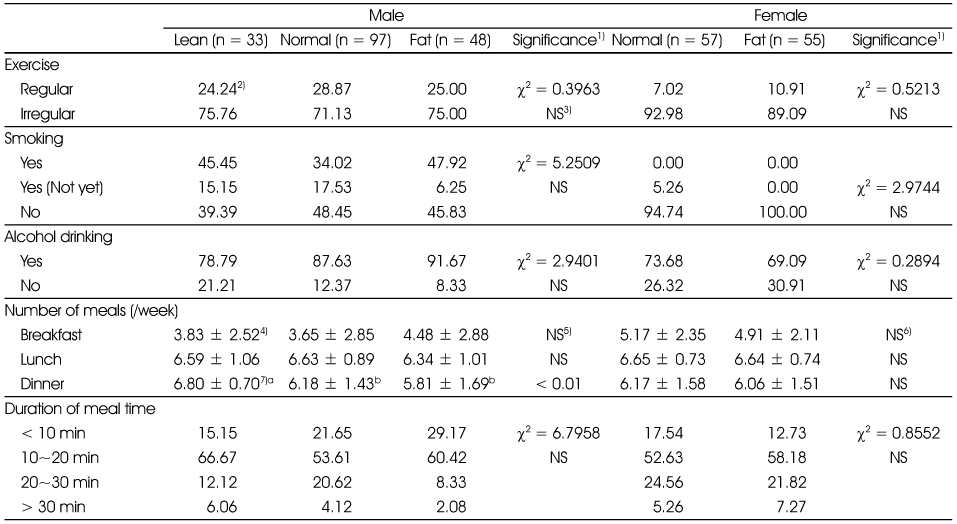
1) Significance as determined by χ2 test, 2) %, 3) Not significant, 4) Mean ± SD, 5) Significance as determined by GLM test (Not significant), 6) Significance as determined by t-test (Not significant), 7) Means with different superscripts (a~b) within a row are significantly different from each at α = 0.05 by Duncan's multiple range test
Figure & Data
REFERENCES
Citations

- Depression and Diet: The Role of Common Foods in Korean Young Adults
Junghyun Park, Hae-Jeung Lee
Food Supplements and Biomaterials for Health.2024;[Epub] CrossRef - Descriptive and Correlative Analysis of Anthropometric, Physiological and Nutritional Characteristics in University Students from Morelia, Mexico
Erasto Hernández-Calderón, África Itzu Luna Rueda, Juan Carlos De la Cruz Castillo Pinea, Olga Ivalú Larios Togo, Daniela Lara y Sánchez
International Journal of Kinanthropometry.2022; 2(2): 36. CrossRef - Survey on Health Status and Food Habits of Male College Students in Wonju Area According to Drinking Behavior
Seung-Lim Lee
Journal of the Korean Dietetic Association.2016; 22(1): 41. CrossRef - A study on blood lipid profiles, aluminum and mercury levels in college students
Eunim Jung, Whajin Hyun, Yoona Ro, Hongmie Lee, Kyunghee Song
Nutrition Research and Practice.2016; 10(4): 442. CrossRef - The Relationships between Body Mass Index, Nutrition Knowledge and the Health Promotion Behavior of Nursing Students
Su Ol Kim
Journal of Korean Biological Nursing Science.2016; 18(2): 87. CrossRef - Evaluation of Dietary Quality in Korea Female according to BMI : From the Korean National Health and Nutrition Examination Survey Data of 2010
In-Suk Kim, Sung-Woo Choi, Eun Jeong
The Korean Journal of Community Living Science.2016; 27(1): 147. CrossRef - A Study on Weight Control Behaviour, Eating Habits and Health-related Life Habits According to Obesity Degree of University Students in Jeonbuk
Hye-Soon Chang
Korean Journal of Human Ecology.2016; 25(1): 73. CrossRef - Nutrition Knowledge, Food Habit Problems and Dietary Attitudes of Nursing Students
Su-Ol Kim, So-Myeong Kim
The Journal of Korean Academic Society of Nursing Education.2015; 21(4): 466. CrossRef - Major Foods and Nutrient Intake Quality According to Body Image Perception among Korean Women: Based on the 2010 Korea National Health and Nutrition Examination Survey Data
Young Suk Lim, Soo Bin Jeon, Hee Mang Kim, So Yeon Jeong, Jae Young Ahn, Hae Ryun Park
Journal of the Korean Dietetic Association.2015; 21(2): 154. CrossRef - Survey on Health-related Factors, Nutrition Knowledge and Food Habits of College Students in Wonju Area
Seung Lim Lee, Sun Hee Lee
Korean Journal of Community Nutrition.2015; 20(2): 96. CrossRef - Health-related Factors, Nutrition Knowledge and Dietary Habits among Nursing and Allied Health College Students
Su Ol Kim
Journal of the Korean Society of School Health.2015; 28(3): 158. CrossRef - Analysis of Weight Control Behaviors by Body Image Perception among Korean Women in Different Age Groups: Using the 2010 Korea National Health and Nutrition Examination Survey Data
Young-Suk Lim, Na-Ri Park, Su-Bin Jeon, So-Yeon Jeong, Zuunnast Tserendejid, Hae-Ryun Park
Korean Journal of Community Nutrition.2015; 20(2): 141. CrossRef - Night Eating and Nutrient Intake Status according to Residence Type in University Students
Ye-Sook Jun, Mi-Kyeong Choi, Yun-Jung Bae
Journal of the Korean Society of Food Science and Nutrition.2015; 44(2): 216. CrossRef - A Study on Food Habits and Nutrient Intakes according to BMI in Food and Nutrition Major and Non-major Female Students in Kyungnam University
Eun-Hee Seo
Korean Journal of Community Nutrition.2014; 19(4): 297. CrossRef - Dietary habits score, nutrients intake and dietary quality related to coffee consumption of college students in Incheon
Yun Ju Lee, Jeong Soon You, Kyung Ja Chang
Journal of Nutrition and Health.2013; 46(6): 560. CrossRef - A Study on Dietary Habits, Body Satisfaction and Nutritional Knowledge by Body Image of Middle School Girl Students in Chungbuk Area
Jee-Young Yeon, Ki-Yong Shin, Soon-Kyu Lee, Hye-Young Lee, Baeg-Won Kang, Hye-Kyung Park
Korean Journal of Community Nutrition.2013; 18(5): 442. CrossRef
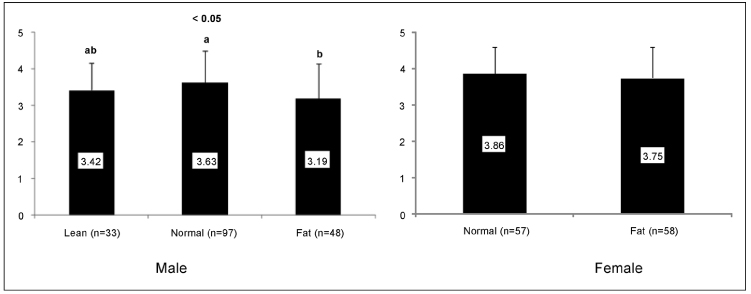
Fig. 1
Age and anthropometric measurements of subjects by gender
1) Mean ± SD
2) Not significant
Age and anthropometric measurements of subjects by body image
1) Significance as determined by GLM test
2) Significance as determined by t-test
3) Mean ± SD
4) Not significant
5) Means with different superscripts (a~c) within a row are significantly different from each at α = 0.05 by Duncan's multiple range test
Satisfaction with body image and interest of weight control in subjects by body image
1) Significance as determined by χ2 test
2) %
Life style and dietary habits of subjects by body image
1) Significance as determined by χ2 test, 2) %, 3) Not significant, 4) Mean ± SD, 5) Significance as determined by GLM test (Not significant), 6) Significance as determined by t-test (Not significant), 7) Means with different superscripts (a~b) within a row are significantly different from each at α = 0.05 by Duncan's multiple range test
Mean daily energy and nutrient intakes of subjects by body image
1) Significance as determined by GLM test, 2) Significance as determined by t-test, 3) Mean ± SD, 4) Not significant, 5) Means with different superscripts (a~b) within a row are significantly different from each at α = 0.05 by Duncan's multiple range test
Food intakes from each food group of subjects by body image
1) Significance as determined by GLM test, 2) Significance as determined by t-test, 3) Mean ± SD, 4) Not significant
NAR and MAR of subjects by body image
1) Significance as determined by GLM test, 2) Significance as determined by t-test, 3) Mean ± SD, 4) Not significant, 5) Means with different superscripts (a~b) within a row are significantly different from each at α = 0.05 by Duncan's multiple range test
Distribution of food group intake pattern (GMVFD)1) of subjects by body image
1) GMVFD: grains, meats, vegetables, fruits, dairys food group
1: food group(s) present, 0: food group (s) absent
For example, GMVFD = 11111 denotes that all food group (grains, meats, vegetables, fruits, dairys food group) were consumed
1) Mean ± SD 2) Not significant
1) Significance as determined by GLM test 2) Significance as determined by t-test 3) Mean ± SD 4) Not significant 5) Means with different superscripts (a~c) within a row are significantly different from each at α = 0.05 by Duncan's multiple range test
1) Significance as determined by χ2 test 2) %
1) Significance as determined by χ2 test, 2) %, 3) Not significant, 4) Mean ± SD, 5) Significance as determined by GLM test (Not significant), 6) Significance as determined by t-test (Not significant), 7) Means with different superscripts (a~b) within a row are significantly different from each at α = 0.05 by Duncan's multiple range test
1) Significance as determined by GLM test, 2) Significance as determined by t-test, 3) Mean ± SD, 4) Not significant, 5) Means with different superscripts (a~b) within a row are significantly different from each at α = 0.05 by Duncan's multiple range test
1) Significance as determined by GLM test, 2) Significance as determined by t-test, 3) Mean ± SD, 4) Not significant
1) Significance as determined by GLM test, 2) Significance as determined by t-test, 3) Mean ± SD, 4) Not significant, 5) Means with different superscripts (a~b) within a row are significantly different from each at α = 0.05 by Duncan's multiple range test
1) GMVFD: grains, meats, vegetables, fruits, dairys food group 1: food group(s) present, 0: food group (s) absent For example, GMVFD = 11111 denotes that all food group (grains, meats, vegetables, fruits, dairys food group) were consumed

 KSCN
KSCN



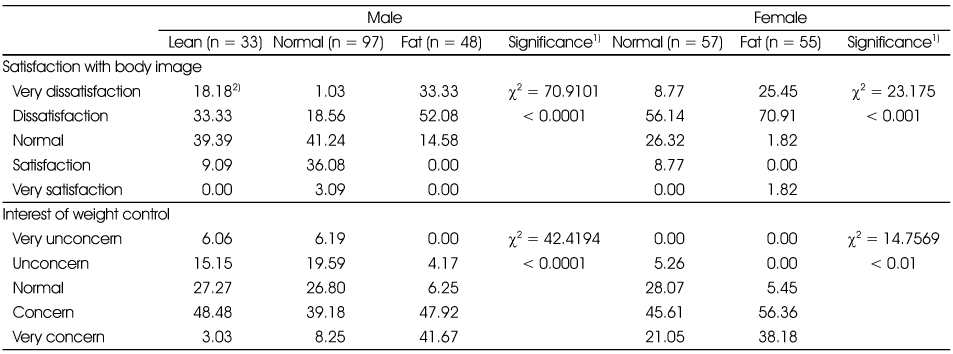
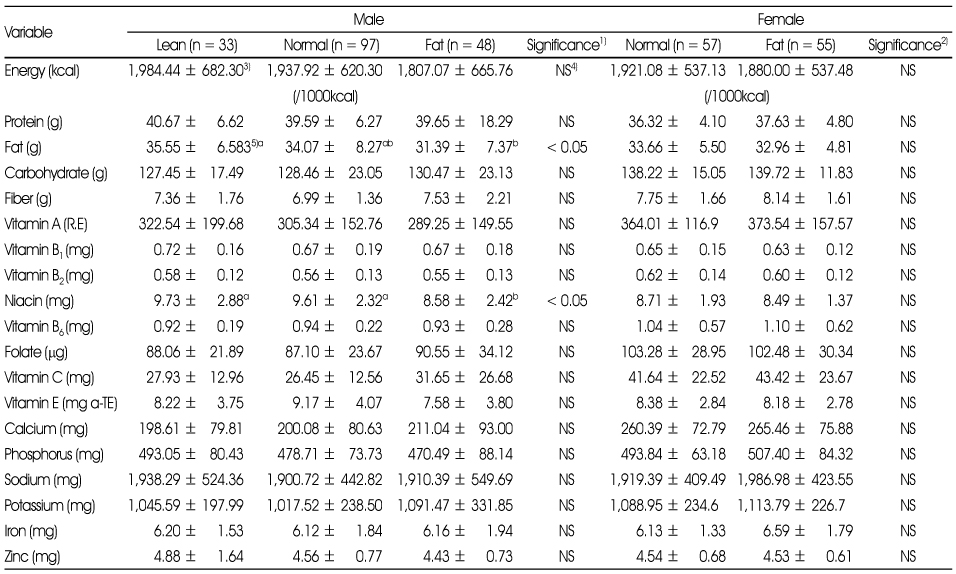
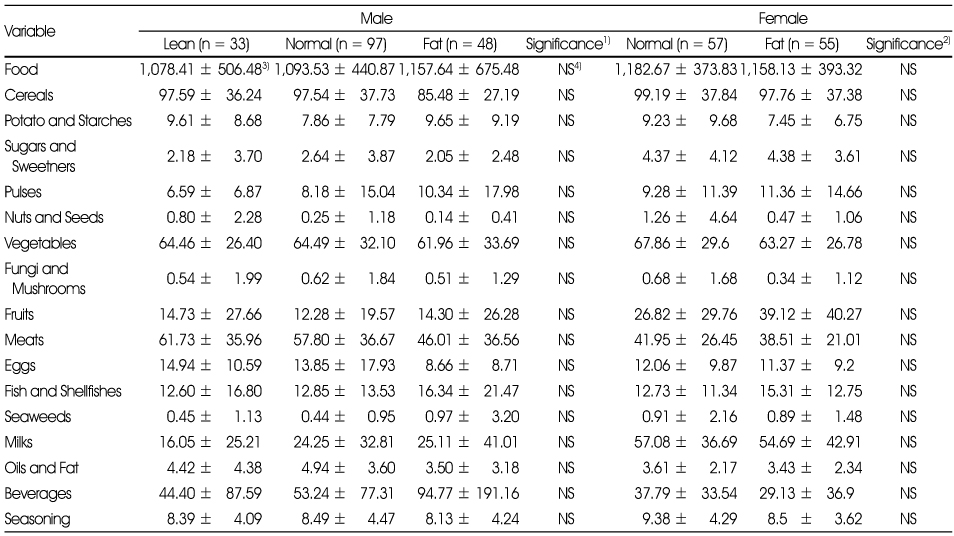
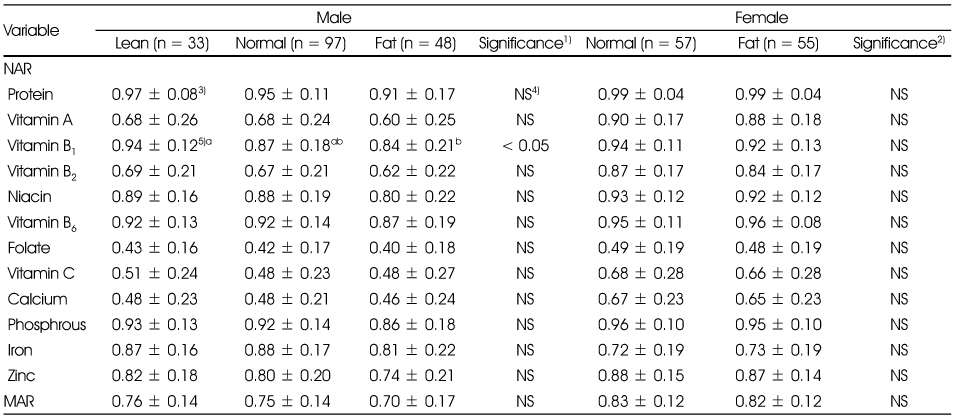

 Cite
Cite


